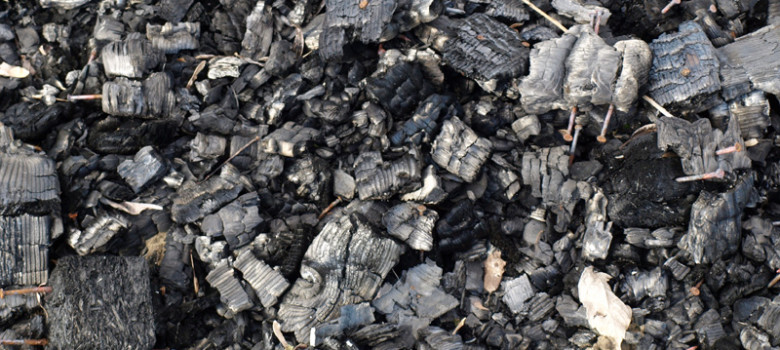
What is biochar?
Biochar, also known as charcoal or Terra Preta, is a carbon-rich product created from the pyrolysis of biomass. Pyrolysis simply refers to the thermochemical decomposition of plant derived organic matter in a low or zero oxygen environment. During this process the biomass is converted to biochar and syngas (which can be captured and used to make heat and power). The lack of oxygen prevents combustion and the hotter the temperature at which the reaction takes place, the quicker pyrolysis takes pace.
The biochar produced varies depending on both the biomass source used and the temperature that pyrolysis takes place. At temperatures of approx 400°C, it will produce more char (the solid part of biochar) while pyrolysis at higher temperatures yields more syngas and a more porous and absorptive biochar, which has greater potential to adsorb toxic substances.
The two main methods of pyrolysis are “fast” pyrolysis and “slow” pyrolysis. Fast pyrolysis yields 60% bio-oil, 20% biochar, and 20% syngas, and can be done in seconds, whereas slow pyrolysis can be optimised to produce substantially more char (~50%), but takes on the order of hours to complete.
Why is biochar such a big deal?
The biochar process makes impressive reading when you see how much and how quickly carbon dioxide is actually released into the atmosphere by plants, animals and humans. Carbon dioxide released by human activities makes up approximately 70% of greenhouse gas emissions. Aside from lowering individual energy use and producing the electricity from greener or renewable sources as mentioned elsewhere on the site, in an effort to actually decrease the amount of Carbon Dioxide in the atmosphere we need to ‘trap’ it. See also Carbon Capture & Storage.
In Photosynthesis, plants and trees use carbon dioxide combined with water and sunlight to produce sugars, thereby locking the carbon within their very matter. Until a plant or tree dies, it will continue to use and store the carbon dioxide, using it as fuel for growth. Upon death, the plant or tree will start to decompose in the air as microbes and fungi begin to break it down. This process releases the carbon dioxide back into the atmosphere within one or two years so it only acts as a carbon sink for a relatively short time.
During pyrolysis, 50% of the carbon locked in the biomass is converted into biochar and the rest is converted to syngas which can be captured and used to produce heat and power. The biochar produced is chemically and biologically more stable than the original carbon form it comes from, and can remain stable in soil for hundreds to thousands of years. Therefore biochar has the potential to play an important role as a long term carbon sink, sequestering the carbon from the atmosphere and partially offsetting greenhouse gas emissions produced by burning fossil fuels.
Biochar use in agriculture
The addition of biochar to agricultural soils can improve crop yield, aiding in retaining nutrients and water, decreasing soil acidity and decreasing the release of non- carbon dioxide green house gases such as methane and nitrous oxide. As mentioned previously, the physical properties of biochar are dependant on the temperature at which it is produced, therefore it can be designed with specific qualities to target the distinct properties of soils. For example, if a more porous biochar is produced and applied to the soil, it will adsorb and lock potential contaminants within its structure; therefore the crops grown will be more containment free.
Is biochar economically viable?
The economic viability of biochar is dependant on a few factors; firstly the cost of the feedstock. If feedstock is available close to the pyrolysis equipment then this makes the process more attractive as the associated transport costs are minimal. In addition, if the feedstock would otherwise require a waste disposal fee, then cost of production of biochar would be further reduced. Another key driver of the economic viability of biochar is related to the returns achievable through the sale of the syngas (resulting from the Pyrolysis process) to energy producers. Biochar can also be used in agriculture, reducing the requirement of fertilizer and also increasing yield. Futhermore the biochar producer or user may benefit from some sort of carbon credit under an emissions trading scheme.
The future of biochar
Biochar, or charcoal, has been produced for hundreds of years and is made regularly on a small scale allowing subsistence farmers to produce small quantities of biochar for their farms of gardens. However, industrial scale production is still in its infancy, with research currently ongoing within the scientific and technological communities focusing on the most effective method of producing it on a large scale.
Biochar offers a very viable solution of carbon sequestration, however there is a long way to go in terms of research and building enough pyrolysis plants until this technology will make a large contribution to mitigating climate change. The UK biochar Research Centre, with its headquarters at the University of Edinburgh, is making good progress in developing this research in this areas and promoting the benefits of biochar.
Benefits
- Biochar is very stable carbon sink, and therefore can become a viable carbon sequestration method.
- As part of the pyrolysis process, syngas is produced as a waste product that can be used to produce power.
- The biochar can be produced to target specific deficiencies in soils to aid agriculture.
- Biochar is easy to produce on a small scale.
Limitations
- Producing biochar on an industrial scale is still at the research level, with the best techniques yet to be established.
- Biochar requires a source of feedstock, which unless harvest locally can be expensive to transport.
- The systems used to create biochar are based on the feedstock type – it is ambitious to expect a ‘One size fits all’ standard system.












No Comments yet! Be the first one.